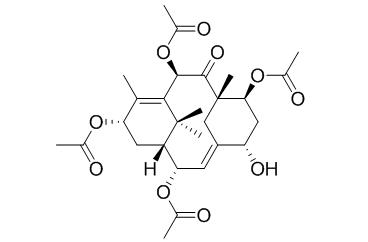Taxin B
Taxin B has toxic effects.
Inquire / Order:
manager@chemfaces.com
Technical Inquiries:
service@chemfaces.com
Tel:
+86-27-84237783
Fax:
+86-27-84254680
Address:
1 Building, No. 83, CheCheng Rd., Wuhan Economic and Technological Development Zone, Wuhan, Hubei 430056, PRC
Providing storage is as stated on the product vial and the vial is kept tightly sealed, the product can be stored for up to
24 months(2-8C).
Wherever possible, you should prepare and use solutions on the same day. However, if you need to make up stock solutions in advance, we recommend that you store the solution as aliquots in tightly sealed vials at -20C. Generally, these will be useable for up to two weeks. Before use, and prior to opening the vial we recommend that you allow your product to equilibrate to room temperature for at least 1 hour.
Need more advice on solubility, usage and handling? Please email to: service@chemfaces.com
The packaging of the product may have turned upside down during transportation, resulting in the natural compounds adhering to the neck or cap of the vial. take the vial out of its packaging and gently shake to let the compounds fall to the bottom of the vial. for liquid products, centrifuge at 200-500 RPM to gather the liquid at the bottom of the vial. try to avoid loss or contamination during handling.
Int J Cosmet Sci.2023, 45(2):155-165.
Horticulturae2024, 10(4), 382.
Enzyme and Microbial Technology2022, 110002.
Food Funct.2022, 13(23):12105-12120.
International J of Green Pharmacy2019, 13(3)
Chinese Medicine2019, 14(1)
J of L. Chroma.&Related Tech2017, 252-258
Nutrients.2018, 11(1):E17
Applied Biological Chemistry 2021, 64(75)
Food Res Int.2022, 157:111207.
Related and Featured Products
Neuro Endocrinol Lett. 2013;34 Suppl 2:130-3.
Yew poisoning of olive baboons (Papio anubis) in captivity: laboratory diagnosis.[Pubmed:
24362105]
Toxic effects of the yew have been known since ancient times. Yew toxicity is due to the content of cyanogenic glycosides and a mixture of alkaloids known as taxines. Taxine B is probably responsible for the most part of adverse effects in poisoned organisms. This particular taxoid is common in body fluids of the yew-poisoned. The present study is engaged with laboratory examination to confirm substances that lead to fatality of a pair of olive baboons (Papio anubis) following ingestion of yew seeds. When both cage mates (male and female) died suddenly, poisoning was suspected because many berries had fallen into the cage from a nearby fruiting yew tree (Taxus baccata) during the windy night before.
METHODS AND RESULTS:
The analysis was performed using electrospray ionization quadrupole time-of-flight mass spectrometry. A flow injection analysis/mass spectrometry setting was prepared for this purpose. The above mentioned mass spectrometry analysis of taxoids confirmed poisoning by taxanes. The presence of Taxin B/isoTaxin B was confirmed in all investigated samples. Apparently in urine and bile there were concentrations ranging 150-220 ng.mL-1 and in blood serum concentrations 25-30 ng.mL-1.
CONCLUSIONS:
It follows from the results obtained that we confirmed that baboons were deadly intoxicated by yew fruits.
Chem Pharm Bull (Tokyo). 2000 Sep;48(9):1344-6.
Taxane diterpenoids from seeds of Taxus mairei.[Pubmed:
10993234]
METHODS AND RESULTS:
A new 2(3-->20) abeotaxane, taxumairone A (1), and a new cis-p-coumaroyl myo-inositol have been isolated from the seeds of Taxus mairei in addition to Taxin B (2), taxinine A, taxuspine X, decinnamoyltaxinine E, 5alpha-cinnamoyloxy-9alpha,10beta,13alpha- triacetoxy-taxa-4(20)11-diene and 5alpha-cinnamoyloxy-2alpha,9alpha,10beta,+ ++13alpha-tetraacetoxy-taxa-4(20)11-diene. The structure of 1 was determined by 2D-NMR spectral analysis and chemical correlation with Taxin B (2).
CONCLUSIONS:
Compound 1 exhibited potent cytotoxicity against human colon carcinoma cells with an ED50 of 0.1 microg/ml.



